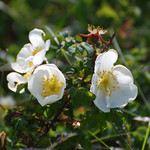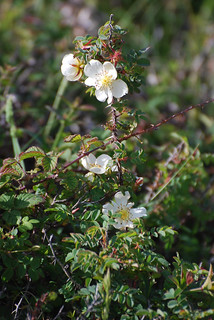White Rose of Scotland (Scots Rose, Burnet Rose)
White Rose of Scotland (Scots Rose, Burnet Rose)
Throughout Britain, Europe and Asia it is found on coastal sand dunes and limestone heath. Next to the thistle, Rosa spinosissima is probably our most emblematic native plant. It has been used as a Scottish emblem since Charles Edward Stuart or 'Bonnie Prince Charlie' (1720-1788) and may have been the source of the Jacobite white cockade.

Flag of Prince Charles Edward Stuart
MrPenguin20, CC BY-SA 3.0 via Wikimedia Commons
The Burnet Rose has become a symbol of Scotland, celebrated in song and poetry. Under the pen name Hugh MacDiarmid, Christopher Murray Grieve (1892-1978) wrote these poignant words from 'The Little White Rose':-
"The rose of all the world is not for me.
I want for my part
Only the little white rose of Scotland.
That smells sharp and sweet - and breaks the heart."
This tough reliable rose is the parent of many good garden hybrids which have a strong fragrance. One particularly old variety with double purple-lilac flowers named 'Mary Queen of Scots' is said to have been brought to Scotland by Mary Stuart (1542-1587) from France in 1561.
The Ancient Romans strewed roses over their dead and graves. This resulted in Hecate, Goddess of the underworld, being depicted wearing a rose garland. In early Christianity roses had a mystical quality and were central to ceremonies surrounding birth, marriage and death. In the Islamic world rose water was used to purify the mosque.
Roses also have a long history as an emblem and are regularly seen in heraldry. For example the white rose is the plant badge of the Clan Keith which dates back to the time Malcolm II (died 1034) and the Battle of Barrie in 1010. David I (c.1080-1153) granted the family lands in Lothian in 1150. Later Robert the Bruce (1274-1329) granted the hereditary Marischal Earldom to Sir Robert Keith after the Battle of Bannockburn in 1314.
George Keith, the 4th Earl Marischal (c.1553-1623) founded Marischal college in Aberdeen and negotiated the marriage of James VI to Anne of Denmark. However Earldom and much of the land was lost following the clans support of the Jacobite cause.
The plant is associated with tartan - the small black hips grown each autumn produce juice which provides a peachy dye if used on its own, and a beautiful purple shade when mixed with alum.

